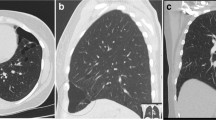Abstract
Purpose
Autosomal dominant hyper-IgE syndrome (AD-HIES) due to heterozygous STAT3 mutation is a primary immunodeficiency characterized by eczema, elevated serum IgE, recurrent infections, and connective tissue and skeletal findings. Healing of pneumonias is often abnormal with formation of pneumatoceles and bronchiectasis. We aimed to explore whether healing after lung surgery is also aberrant.
Methods
We retrospectively analyzed the medical records of 32 patients with AD-HIES who received lung surgery for the management of pulmonary infections from 1960 to 2011. We collected information including patient demographics, STAT3 mutation status, clinical history, surgical and medical procedures performed, complications, related medical treatments, and outcomes.
Results
More than 50 % of lung surgeries had associated complications, with the majority being prolonged bronchopleural fistulae. These fistulae often led to empyemas that necessitated additional interventions including prolonged antibiotics, prolonged thoracostomy tube drainage and re-operations.
Conclusion
Lung surgery in AD-HIES patients is associated with high complication rates. STAT3 mutations likely lead to abnormalities in tissue remodelling that are further exacerbated by infection.


Similar content being viewed by others
References
Holland SM, DeLeo FR, Elloumi HZ, et al. STAT3 mutations in the hyper-IgE syndrome. N Engl J Med. 2007;357:1608–19.
Minegishi Y, Saito M, Tsuchiya S, et al. Dominant-negative mutations in the DNA-binding domain of STAT3 cause hyper-IgE syndrome. Nature. 2007;448:1058–62.
Sowerwine KJ, Holland SM, Freeman AF. Hyper-IgE syndrome update. Ann N Y Acad Sci. 2012;1250:25–32.
Chandesris M, Melki I, Natividad A, et al. Autosomal dominant STAT3 deficiency and hyper-IgE syndrome: molecular, cellular, and clinical features from a French national survey. Medicine. 2012;91:e1–e19.
Freeman AF, Kleiner DE, Nadiminti H, et al. Causes of death in hyper-IgE syndrome. J Allergy Clin Immunol. 2007;119:1234–40.
Melia E, Freeman AF, Shea YR, et al. Pulmonary nontuberculous mycobacterial infections in hyper-IgE syndrome. J Allergy Clin Immunol. 2009;124:617–8.
Vinh DC, Sugui JA, Hsu AP, et al. Invasive fungal disease in autosomal-dominant hyper-IgE syndrome. J Allergy Clin Immunol. 2010;125:1389–90.
Grimbacher B, Schaffer A, Holland SM, et al. Genetic linkage of hyper-IgE syndrome to chromosome 4. Am J Hum Genet. 1999;65:735–44.
Schimke LF, Sawalle-Belohradsky J, Roesler J, et al. Diagnostic approach to the hyper-IgE syndromes: immunologic and clinical key findings to differentiate hyper-IgE syndromes from atopic dermatitis. J Allergy Clin Immunol. 2010;126:611–7.e.1.
Heimall J, Davis J, Shaw PA, et al. Paucity of genotype-phenotype correlations in STAT3 mutation positive Hyper IgE syndrome (HIES). Clin Immunol. 2011;139:75–84.
Sagan D, Gozdziuk K, Korobowicz E. Predictive and prognostic value of preoperative symptoms in the surgical treatment of pulmonary aspergilloma. J Surg Res. 2010;163:e35–43.
Sagan D, Gozdziuk K. Surgery for pulmonary aspergilloma in immunocompetent patients: no benefit from adjuvant antifungal pharmacotherapy. Ann Thorac Surg. 2010;89:1603–10.
Sekhsaria V, Dodd LE, Hsu AP. Plasma metalloproteinase levels are dysregulated in signal transduction and transcription 3 mutated hyper-IgE syndrome. J Allergy Clin Immunol. 2011;128:1124–7.
Crosby LM, Waters CM. Epithelial repair mechanisms in the lung. Am J Physiol Lung Cell Mol Physiol. 2010;298:L715–31.
Lagente V, Boichot E. Role of matrix metalloproteinases in the inflammatory process of respiratory diseases. J Mol Cell Cardiol. 2010;48:440–4.
Kida H, Mucenski ML, Thitoff AR, et al. GP130-STAT3 regulates epithelial cell migration and is required for repair of the bronchiolar epithelium. Am J Pathol. 2008;172:1542–54.
Goussetis E, Peristeri I, Kitra V, et al. Successful long-term immunologic reconstitution by allogeneic hematopoietic stem cell transplantation cures patients with autosomal dominant hyper-IgE syndrome. J Allergy Clin Immunol. 2010;126:392–4.
Acknowledgments
We thank all of the participants in this study, their families, and referring physicians who make our research possible. This research was supported by the Division of Intramural Research of the NIAID and the Center for Cancer Research of the National Cancer Institute, NIH, Bethesda, MD 20892. The views expressed in this article are those of the authors and do not reflect the official policy of the U.S. Government. This work was supported by the German Research Foundation (DFG RE2799/3-1), the Fritz-Thyssen research foundation grant (Az. 10.07.1.159) (to EDR), and Kindness for Kids (to J.S-B.).
Author information
Authors and Affiliations
Corresponding author
Additional information
Key message
Patients with autosomal dominant hyper-IgE syndrome, a primary immunodeficiency, have high rates of complications after lung parenchyma surgery suggesting abnormal tissue remodeling.
Rights and permissions
About this article
Cite this article
Freeman, A.F., Renner, E.D., Henderson, C. et al. Lung Parenchyma Surgery in Autosomal Dominant Hyper-IgE Syndrome. J Clin Immunol 33, 896–902 (2013). https://doi.org/10.1007/s10875-013-9890-5
Received:
Accepted:
Published:
Issue Date:
DOI: https://doi.org/10.1007/s10875-013-9890-5




